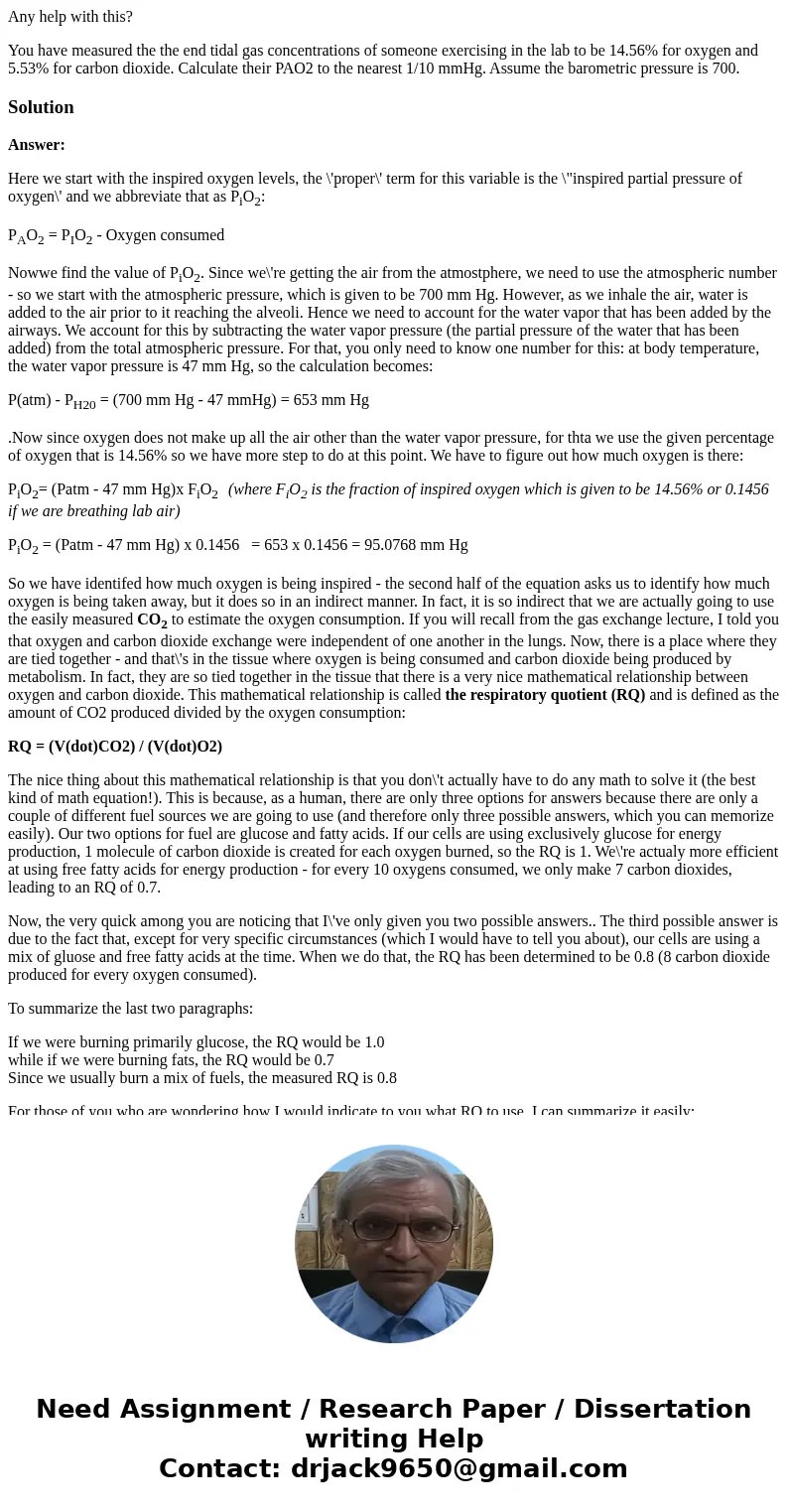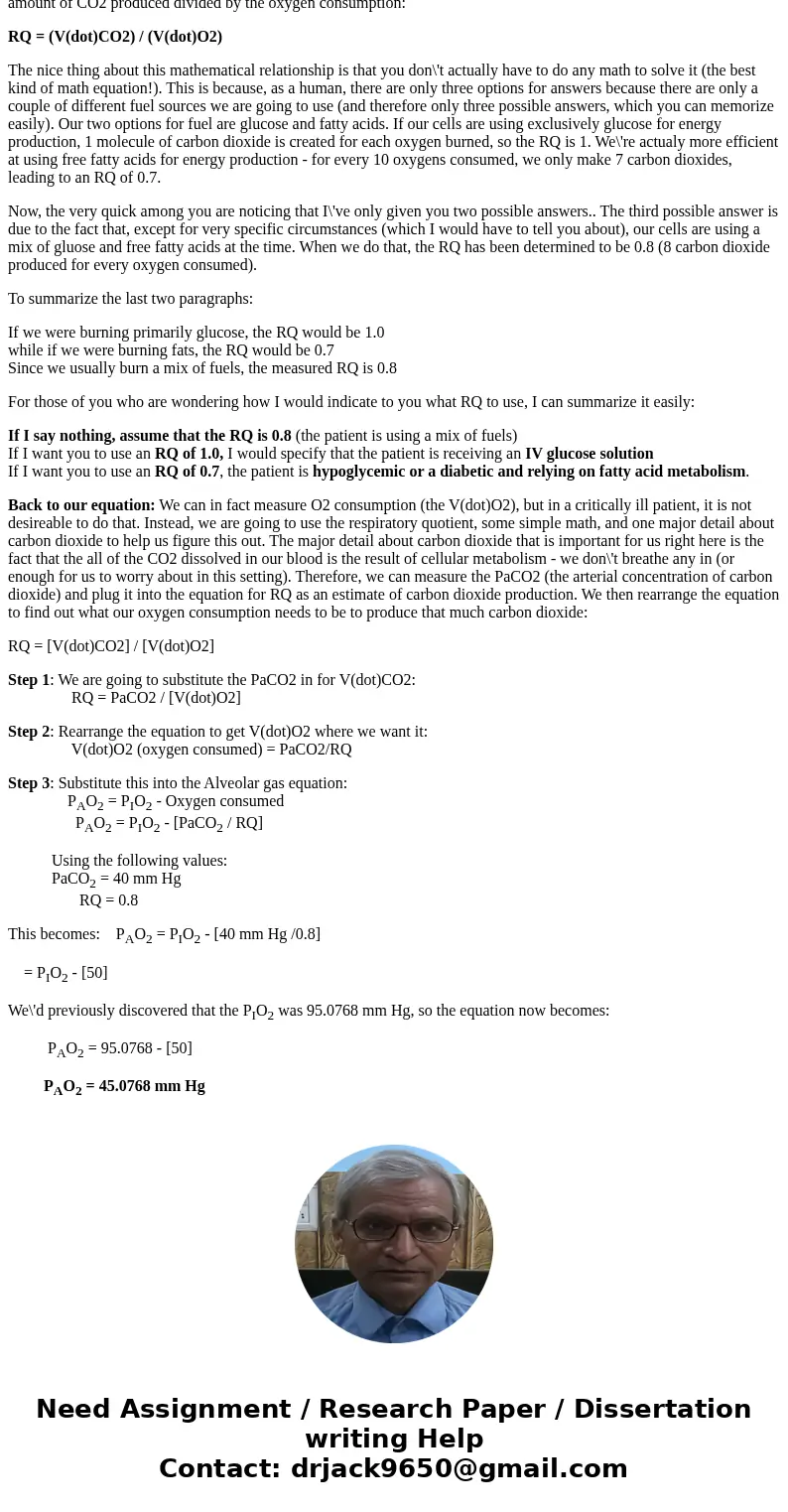Any help with this You have measured the the end tidal gas c
Any help with this?
You have measured the the end tidal gas concentrations of someone exercising in the lab to be 14.56% for oxygen and 5.53% for carbon dioxide. Calculate their PAO2 to the nearest 1/10 mmHg. Assume the barometric pressure is 700.
Solution
Answer:
Here we start with the inspired oxygen levels, the \'proper\' term for this variable is the \"inspired partial pressure of oxygen\' and we abbreviate that as PiO2:
PAO2 = PIO2 - Oxygen consumed
Nowwe find the value of PiO2. Since we\'re getting the air from the atmostphere, we need to use the atmospheric number - so we start with the atmospheric pressure, which is given to be 700 mm Hg. However, as we inhale the air, water is added to the air prior to it reaching the alveoli. Hence we need to account for the water vapor that has been added by the airways. We account for this by subtracting the water vapor pressure (the partial pressure of the water that has been added) from the total atmospheric pressure. For that, you only need to know one number for this: at body temperature, the water vapor pressure is 47 mm Hg, so the calculation becomes:
P(atm) - PH20 = (700 mm Hg - 47 mmHg) = 653 mm Hg
.Now since oxygen does not make up all the air other than the water vapor pressure, for thta we use the given percentage of oxygen that is 14.56% so we have more step to do at this point. We have to figure out how much oxygen is there:
PiO2= (Patm - 47 mm Hg)x FiO2 (where FiO2 is the fraction of inspired oxygen which is given to be 14.56% or 0.1456 if we are breathing lab air)
PiO2 = (Patm - 47 mm Hg) x 0.1456 = 653 x 0.1456 = 95.0768 mm Hg
So we have identifed how much oxygen is being inspired - the second half of the equation asks us to identify how much oxygen is being taken away, but it does so in an indirect manner. In fact, it is so indirect that we are actually going to use the easily measured CO2 to estimate the oxygen consumption. If you will recall from the gas exchange lecture, I told you that oxygen and carbon dioxide exchange were independent of one another in the lungs. Now, there is a place where they are tied together - and that\'s in the tissue where oxygen is being consumed and carbon dioxide being produced by metabolism. In fact, they are so tied together in the tissue that there is a very nice mathematical relationship between oxygen and carbon dioxide. This mathematical relationship is called the respiratory quotient (RQ) and is defined as the amount of CO2 produced divided by the oxygen consumption:
RQ = (V(dot)CO2) / (V(dot)O2)
The nice thing about this mathematical relationship is that you don\'t actually have to do any math to solve it (the best kind of math equation!). This is because, as a human, there are only three options for answers because there are only a couple of different fuel sources we are going to use (and therefore only three possible answers, which you can memorize easily). Our two options for fuel are glucose and fatty acids. If our cells are using exclusively glucose for energy production, 1 molecule of carbon dioxide is created for each oxygen burned, so the RQ is 1. We\'re actualy more efficient at using free fatty acids for energy production - for every 10 oxygens consumed, we only make 7 carbon dioxides, leading to an RQ of 0.7.
Now, the very quick among you are noticing that I\'ve only given you two possible answers.. The third possible answer is due to the fact that, except for very specific circumstances (which I would have to tell you about), our cells are using a mix of gluose and free fatty acids at the time. When we do that, the RQ has been determined to be 0.8 (8 carbon dioxide produced for every oxygen consumed).
To summarize the last two paragraphs:
If we were burning primarily glucose, the RQ would be 1.0
while if we were burning fats, the RQ would be 0.7
Since we usually burn a mix of fuels, the measured RQ is 0.8
For those of you who are wondering how I would indicate to you what RQ to use, I can summarize it easily:
If I say nothing, assume that the RQ is 0.8 (the patient is using a mix of fuels)
If I want you to use an RQ of 1.0, I would specify that the patient is receiving an IV glucose solution
If I want you to use an RQ of 0.7, the patient is hypoglycemic or a diabetic and relying on fatty acid metabolism.
Back to our equation: We can in fact measure O2 consumption (the V(dot)O2), but in a critically ill patient, it is not desireable to do that. Instead, we are going to use the respiratory quotient, some simple math, and one major detail about carbon dioxide to help us figure this out. The major detail about carbon dioxide that is important for us right here is the fact that the all of the CO2 dissolved in our blood is the result of cellular metabolism - we don\'t breathe any in (or enough for us to worry about in this setting). Therefore, we can measure the PaCO2 (the arterial concentration of carbon dioxide) and plug it into the equation for RQ as an estimate of carbon dioxide production. We then rearrange the equation to find out what our oxygen consumption needs to be to produce that much carbon dioxide:
RQ = [V(dot)CO2] / [V(dot)O2]
Step 1: We are going to substitute the PaCO2 in for V(dot)CO2:
RQ = PaCO2 / [V(dot)O2]
Step 2: Rearrange the equation to get V(dot)O2 where we want it:
V(dot)O2 (oxygen consumed) = PaCO2/RQ
Step 3: Substitute this into the Alveolar gas equation:
PAO2 = PIO2 - Oxygen consumed
PAO2 = PIO2 - [PaCO2 / RQ]
Using the following values:
PaCO2 = 40 mm Hg
RQ = 0.8
This becomes: PAO2 = PIO2 - [40 mm Hg /0.8]
= PIO2 - [50]
We\'d previously discovered that the PIO2 was 95.0768 mm Hg, so the equation now becomes:
PAO2 = 95.0768 - [50]
PAO2 = 45.0768 mm Hg


 Homework Sourse
Homework Sourse